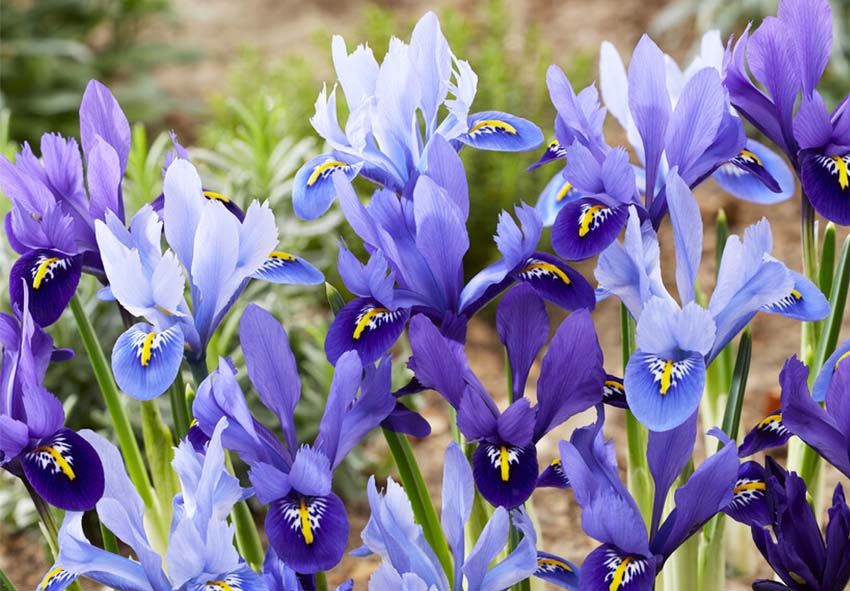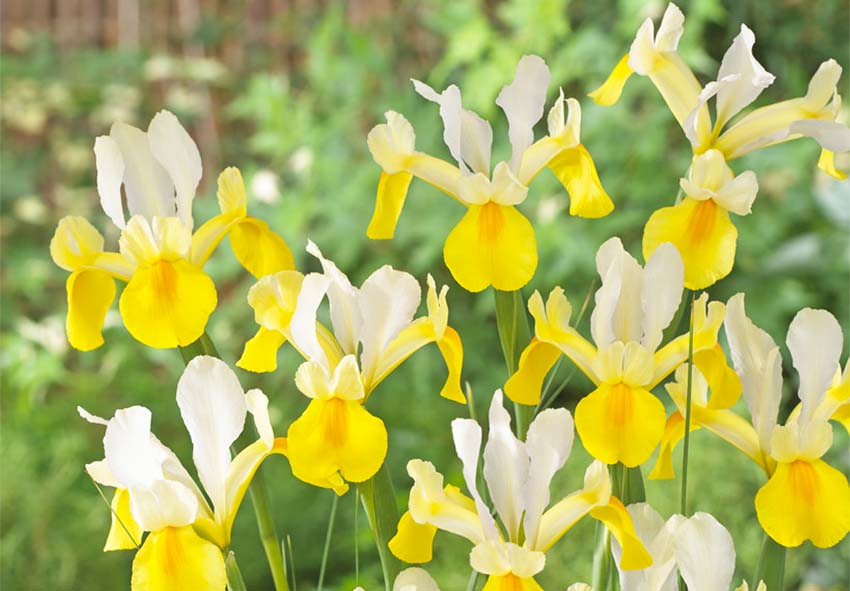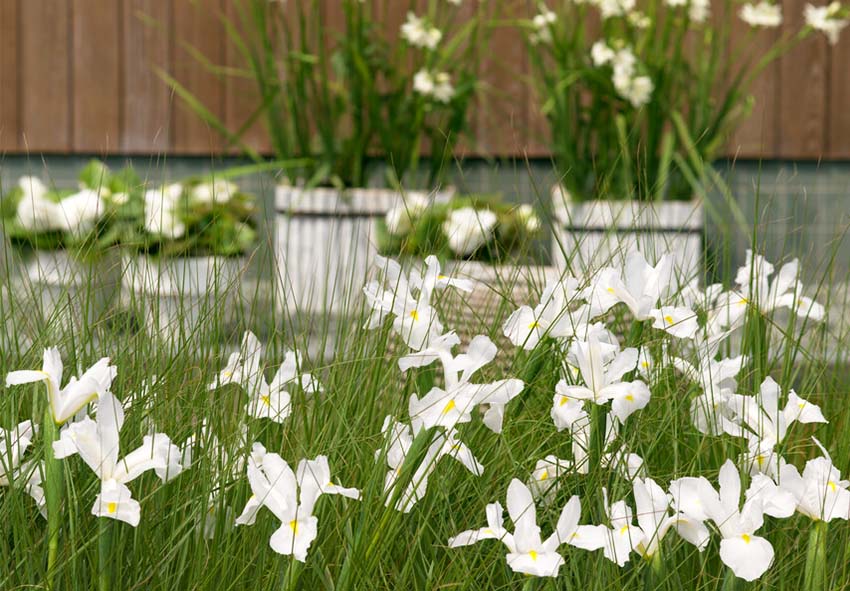Dutch Irises are a favorite among gardeners for their striking colors and elegant shapes. They are versatile, easy to care for, and make a beautiful addition to any garden. This article will explore the benefits of using these stunning flowers in garden design, provide tips on selecting the right varieties and offer creative design ideas. Moreover in other articles you can find even more information and practical advice on planting and caring for Dutch Irises.
Benefits of Using Dutch Irises in Garden Design

Dutch Irises are a fantastic addition to any garden, offering a range of benefits that enhance your outdoor space. Their vibrant colors and unique shapes bring aesthetic appeal, while their versatility allows them to fit seamlessly into various garden styles. Moreover, Dutch Irises are low maintenance, making them an excellent choice for gardeners of all experience levels. Let’s explore these benefits in more detail.
- Aesthetic Appeal
Dutch Irises are known for their vibrant colors, ranging from deep purples and blues to bright yellows and whites. Their unique shapes and intricate patterns add a touch of sophistication to any garden. Whether used as focal points or accents, Dutch Irises can enhance the visual interest of your garden, creating a dynamic and colorful landscape.
- Versatility
Dutch Irises are incredibly versatile, making them suitable for various garden styles. They can be integrated into mixed flower beds, used to create striking borders, planted in rock gardens, or grown in containers. Their adaptability means they can be used in formal garden designs, cottage gardens, or even minimalist landscapes, providing endless possibilities for creative garden planning.
- Low Maintenance
One of the greatest benefits of Dutch Irises is their low maintenance requirements. Once planted, they require minimal care, making them ideal for gardeners who want beautiful flowers without a lot of fuss. Dutch Irises are generally pestresistant and droughttolerant, which adds to their appeal as a lowmaintenance plant.
Choosing the Right Dutch Iris Varieties
Selecting the right Dutch Iris varieties is crucial to achieving the desired look and performance in your garden. With a wide array of colors, growth habits, and bloom times, there’s a Dutch Iris variety to suit every garden style and preference. Understanding the characteristics of popular varieties, considering color selection, and evaluating growth habits will help you make the best choices for your garden.
Popular Varieties

There are several popular Dutch Iris varieties to choose from, each with its unique characteristics. Some favorites include:
- Blue Magic: Deep blue flowers with yellow markings. Blooms in late spring to early summer. Height: 2024 inches
- White Excelsior: Pure white blooms with yellow throats. Blooms in mid to late spring. Height: 1822 inches
- Apollo: Bright yellow flowers with orange accents. Blooms in late spring. Height: 2024 inches
- Frans Hals: Bicolor flowers with orange and white petals. Blooms in late spring to early summer. Height: 1822 inches
- Bronze Beauty: Copperybronze flowers with golden highlights. Blooms in late spring. Height: 2024 inches
Color Selection
When selecting Dutch Iris varieties, consider the color scheme of your garden. Dutch Irises are available in a wide range of colors, so you can choose varieties that complement your existing plants or create a bold new palette. Mix and match colors for a dynamic look, or stick to a single color for a more cohesive design.
Growth Habit
Dutch Irises vary in height and growth habit, so it’s essential to select varieties that suit your garden layout. Some varieties grow taller and make excellent backdrops for shorter plants, while others are more compact and work well in the front of borders or in containers. Consider the mature height and spread of each variety to ensure they fit well in your garden design.
Design Ideas for Incorporating Dutch Irises
Dutch Irises offer endless design possibilities, from mixed flower beds to elegant borders and even container gardening. Their striking blooms can be combined with other plants to create stunning visual displays in any garden setting. By exploring different design ideas, you can find creative ways to incorporate Dutch Irises into your landscape, enhancing both the beauty and functionality of your garden.
Container Gardening

Dutch Irises can also be grown successfully in containers, allowing you to enjoy their beauty on patios, balconies, or other small spaces. Here are some tips for you:
- Choose large containers with good drainage to accommodate Dutch Irises’ root systems.
- Mix Dutch Irises with trailing plants like ivy or creeping jenny for a cascading effect.
- Combine with compact annuals such as pansies or lobelia for a burst of color.
- Use tall ornamental grasses or dwarf evergreens as a backdrop to create height.
- Incorporate herbs like rosemary or lavender for fragrance and culinary use.
Border Plantings
Create attractive borders with Dutch Irises by planting them along pathways or garden edges. Their upright growth and colorful blooms make them perfect for adding structure and visual interest. Companion plants like lavender, salvia, and ornamental grasses can enhance the look of your borders while providing contrast in color and form.
Rock Gardens and Slopes
Dutch Irises thrive in rock gardens and on slopes, where their drainage needs are easily met. Their vibrant colors stand out against the neutral tones of rocks and stones. Arrange them in groups among other rock garden plants like sedums, thyme, and dwarf conifers for a natural, cohesive look.
Mixed Flower Beds
Dutch Irises can be a stunning addition to mixed flower beds. Here are some tips for mixing them with other pants in you garden:
- Combine Dutch Irises with tulips and daffodils for a spring bloom display.
- Pair with summerblooming perennials like coneflowers and daylilies for continuous color.
- Mix with annuals such as marigolds and petunias to fill in gaps and add vibrant colors.
- Use ground covers like creeping thyme or sweet alyssum to create a lush, layered effect.
- Incorporate foliage plants like hostas or ferns for added texture and visual interest.
Conclusion
Incorporating Dutch Irises into your garden design offers numerous benefits, from their aesthetic appeal and versatility to their low maintenance needs. Whether you choose to plant them in mixed beds, borders, rock gardens, or containers, these beautiful flowers will add color and elegance to your outdoor space. Our gardening blog is a perfect place to find all the information you need. Experiment with different design ideas and care tips to enjoy vibrant, healthy Dutch Irises in your garden.
Frequently Asked Questions (FAQs) about Irises in Garden Design
1. How do I choose the best Dutch Iris varieties for my garden?
Selecting the best Dutch Iris varieties involves considering factors such as color preferences, growth habits, and height. Popular varieties include ‘Apollo’, ‘Frans Hals’, and ‘Bronze Beauty’, each offering unique characteristics to enhance your garden’s aesthetic.
2. Can I order Dutch Irises from your online store?
Yes, you can! Our online store Dutch-bulbs.com offers a wide selection of Dutch Irises, including different varieties and colors. We take pride in providing top-quality plants that are carefully cultivated and shipped with care to ensure they reach you in perfect condition. Explore our collection and place your order for a delightful addition to your home or garden.
3. Can Dutch Irises be grown in containers?
Yes, Dutch Irises can be successfully grown in containers. Ensure the container has good drainage, use well-draining soil, and place the container in a sunny spot. Water regularly but avoid waterlogging.
4. What are the benefits of incorporating Dutch Irises into garden borders?
Dutch Irises add vibrant colors and unique shapes to garden borders, creating visual interest. They complement a variety of companion plants and can help define the edges of garden beds, adding structure and beauty.
5. How do I care for Dutch Irises during the growing season?
Caring for Dutch Irises involves providing adequate sunlight, watering regularly without overwatering, and ensuring well-drained soil. Mulching helps retain moisture and keep the roots cool, while deadheading spent blooms promotes new growth.
Published: 09.07.2024
